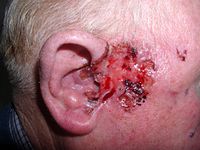
Photo from wikipedia
Mammary analogue secretory carcinoma (MASC) of the salivary glands is a recently described neoplasm of the salivary glands with a characteristic morphology complemented by a specific cytogenetic translocation and gene… Click to show full abstract
Mammary analogue secretory carcinoma (MASC) of the salivary glands is a recently described neoplasm of the salivary glands with a characteristic morphology complemented by a specific cytogenetic translocation and gene rearrangements. Although immunophenotypic and cytogenetic differences allow for a more reliable distinction, ultrastructural features can also provide important information about the relationship between MASC, classic acinic cell carcinoma (AciCC), and AciCC intercalated duct cell-predominant variant. Following approval from the hospital’s institutional review board, 7 cases of MASC, 8 cases of classic AciCC, and 4 cases of AciCC intercalated duct cell-predominant variant were retrieved from the pathology files of Massachusetts General Hospital from 2012 to 2015. Electron microscopy was performed using formalin-fixed, paraffin-embedded tissue. Ultrastructural features of all 19 neoplasms of the salivary glands were recorded. The predominant cell-types observed in MASC are those with intercalated/striated duct cell differentiation. These features include prominent invaginations of the cell surface studded with microvilli, and some intra- and intercellular lumina also with a microvillous surface. Classic AciCC dominant cell-type recapitulates acinar cell differentiation. These cells contain large intracytoplasmic zymogen-like granules. AciCC intercalated duct cell-predominant variant showed both cell populations in various proportions with the intercalated/striated duct cell type usually being the dominant one. MASC presents with distinctive ultrastructural features that allows its proper differentiation from classic AciCC. However, significant ultrastructural features overlaps between both AciCC intercalated duct cells-predominant and classic AciCC and MASC. These findings indicate a very close proximity between these tumors.
Journal Title: Head and Neck Pathology
Year Published: 2017
Link to full text (if available)
Share on Social Media: Sign Up to like & get
recommendations!